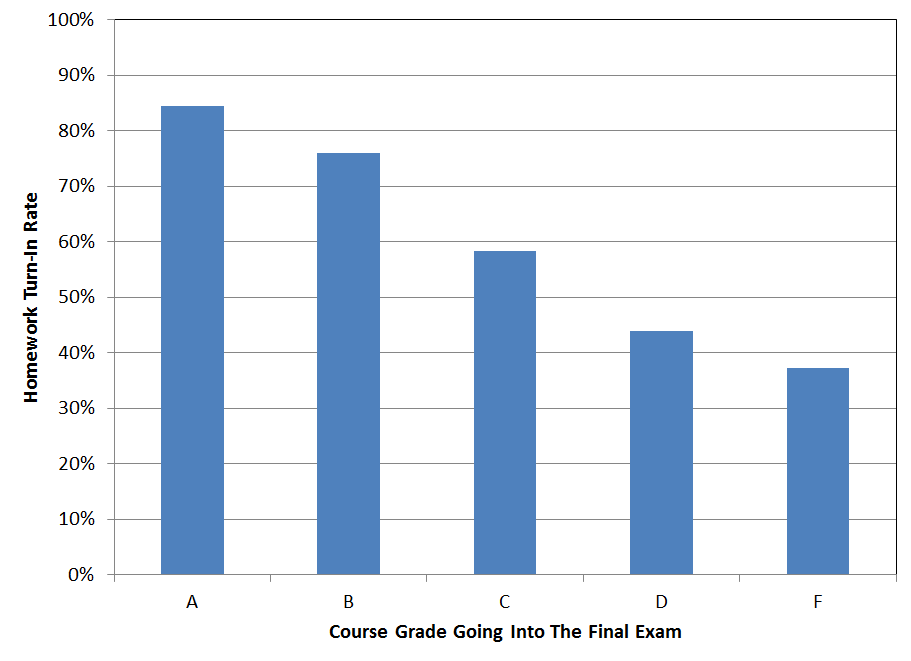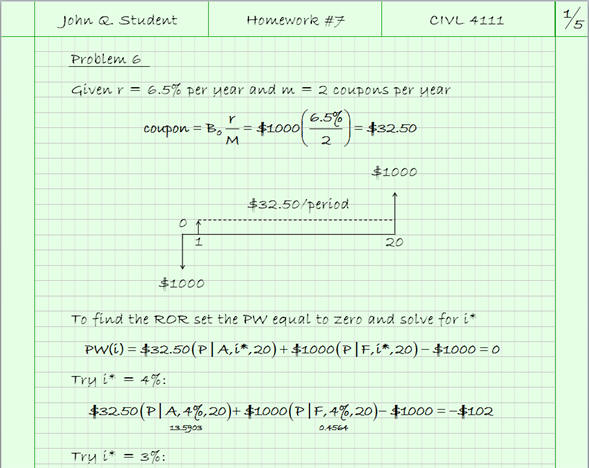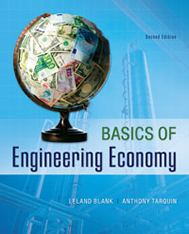Syllabus
Instructor Information
Dr. Roger W. Meier |
“Engineering ... is the art of doing ... with one dollar [what] any bungler can do with two after a fashion.” Arthur Mellen Wellington (1887) |
Course Objectives
This course will introduce you to engineering economics, which is the application of economics and decision theory to the evaluation of engineering alternatives in planning, developing, constructing, and managing engineering projects. The desired outcomes from this course are as follows:
-
An ability to account for the time value of money in economic analyses;
-
An ability to make economic decisions using present worth, annual worth, future worth, and capitalized cost;
-
An ability to calculate rates of return on investments;
-
An ability to calculate benefit-cost ratios of public works projects;
-
An ability to make economic decisions involving mortgages, car loans, bonds, stocks, and rent-to-own purchases;
-
An ability to calculate annual depreciation amounts for tangible assets using straight-line, declining balance, and MACRS depreciation.
Textbook
The required textbook for this course is Basics of Engineering Economy, 2nd Edition by Leland Blank and Anthony Tarquin (McGraw-Hill, 2014)
This is available in hardback and e-book versions. Most of the homework problems I'll assign are from the textbook, so you definitely need a copy. Make sure you get the second edition and not the first edition. There is also a softcover international edition that is identical to the domestic edition (but hard to find).
Supplemental Material
When you eventually take the FE Exam (you do intend to take the FE Exam, don't you?) you will be furnished an electronic copy of the NCEES FE Reference Handbook at the exam site. That is the only reference material you will be allowed to use during the exam. To make sure you're comfortable using that document, I've included a copy of the Engineering Economics section of the NCEES FE Reference Handbook here. I encourage you to use it on your homework assignments to become familiar with it.
The textbook has a
companion website for students that includes worked solutions to every third end-of-chapter problem (a great way to prepare for tests), a glossary of all the terms used in the textbook, and short podcasts (typically 5-10 minutes long) that explain almost all of the concepts covered in the textbook.Student Expectations
In this course, the concepts aren't particularly difficult and the mathematical rigor never exceeds that of high school algebra, but 25% of students fail to earn a C or better every semester. As in most engineering courses, you will learn the material best by doing lots of problems. Therefore we will spend most of our class time working examples. If you have not done the assigned reading prior to class, you will not be able to follow the examples. This is the biggest single mistake that students make and the root cause of most failures. Class time is too short to read the textbook to you. My job is to clarify what is in the textbook, answer questions, and work examples.
Since we will be working example problems in class, you should bring your calculator to class each day along with your textbook and the Engineering Economics section of the NCEES FE Reference Handbook.
Homework Assignments
Multiple homework problems will be assigned from the textbook after every class. These assignments will be posted on the Homework page of the course website. You are responsible for checking the website to obtain the assignments whether or not I mention the assignment in class.
You should make a concerted effort to at least try all of the homework problems. Why? The graph below shows the relationship between the percentage of homework sets turned in and the course grades going into the final exam last Spring semester:

This is not a coincidence. The only way you can make it through a typical 5-problem exam in 55 minutes is if you've done those types of calculations before on the homework. It doesn't matter if you get the homework answer correct (these are turn-in rates, not homework grades) as long as you've tried doing those types of problems prior to the exam. You simply won't have enough time during the exam to learn as you go along.
Unless otherwise stated, all homework will be due at the beginning of the next class period. That means 8:00, not 8:01 or 8:02. LATE HOMEWORK WILL NOT BE ACCEPTED. If you are unable to complete an assignment due to illness, athletic team travel, family emergencies, etc., contact me before it is due to make alternate arrangements. I'll be glad to work with you to complete the assignment.
Homework should be neatly written on engineering paper (not graph paper or lined notebook paper) using one side only. If a solution involves a series of calculations (as they usually do), all of the steps must be included and must be clearly identified. As shown below, the calculations should flow in a logical order down the page with just one calculation on each line. The final answer should be boxed or underlined. If I can't follow your solution, it's wrong.

When you turn your homework in, please make sure it is stapled in the upper left corner then fold it in half lengthwise and write your name on the side containing the staple near the top edge. I will return homework by passing around an alphabetized stack and this will make it easy for you to find yours in the stack.
I encourage you to work together on the homework, but you must do your own work. If what you hand in is simply a transcription of another student’s homework, both will be returned with a grade of zero.
Homework will not be "graded" per se. Instead, for each assigned problem, you will earn one checkmark for working the problem through to a solution and a second checkmark if that solution is correct. On the last day of class, if you have accrued at least 60% of the maximum possible number of check marks, you will have earned the right to either (a) drop your lowest test grade up to that point, or (b) skip the final exam if you have a test average of 89.5 or above.
I realize that solution manuals are available online. Copying solutions from the solution manual is cheating, pure and simple, and violates the University of Memphis Code of Student Rights and Responsibilities. If you are caught using a published solution manual, you will lose your right to have your lowest test grade dropped
.Examinations
There will be three one-hour exams plus a comprehensive two-hour final exam. As mentioned above, all of the exams will be closed-book and closed-note, but you will be provided with a copy of the Engineering Economics chapter from the NCEES FE Reference Handbook at the start of each test. Please return it to me with your completed test so we can reuse it on the next test.
Make-up exams will only be permitted for medical reasons, family emergencies, religious holidays, or official University business. Written documentation is required and you must notify me in advance.
Grading
The average of your one-hour test scores constitutes 70% of your course grade and your final exam score constitutes the remaining 30% of your grade. If you qualify to skip the final exam, the average of your one-hour test scores constitutes 100% of your course grade.
I will not be using plus/minus grading in this class.
Everyone with a final grade of 89.5 or above will have earned an A; 79.5 or above, a B; 69.5 or above, a C; and 59.5 or above, a D. Remember, you are required to get at least a C in this course for it to count toward graduation.I do not believe in curving grades and neither should you. Grading on the curve means that for every student assigned an A there must be one student assigned an F. Would you want to be that student? If you have demonstrated mastery of the course material through your examinations, you will have earned an A regardless of your classmates’ performance. That means everyone in the class could earn an A (and I’d be absolutely delighted if that were the case).
